Housing Element Update
Garden Grove Housing Element 6th Cycle Update
The City's Housing Element was certified by the California Department of Housing and Community Development (HCD) on December 12, 2023, confirming the City's compliance with the State's Housing Element Law (Article 10.6 of the Government Code). The Housing Element is a chapter of the City’s General Plan, which identifies programs and policies that facilitate the production of housing. Every eight years, the State tasks the Southern California region with planning for the development of a prescribed number of housing units at all income levels in a process known as RHNA.
The City’s Certified 6th Cycle (2021-2029) Housing Element and HCD's certification letter can be viewed below.
Through this webpage, you will find educational material related to the Housing Element, answers to Frequently Asked Questions (FAQs), and other resources.
Housing Element
Since 1969, California has required that all local governments adequately plan to meet the housing needs of everyone in the community. California’s local governments meet this requirement by adopting housing plans as part of their general plan, which is also required by the state. General plans serve as the local government’s blueprint for how the city and/or county will grow and develop and includes seven elements: land use, transportation, conservation, noise, open space, safety, and housing. The law mandating that housing be included as an element of each jurisdiction’s general plan is known as the Housing-Element Law.
California’s Housing-Element Law acknowledges that, in order for the private market to adequately address the housing needs and demands of Californians, local governments must adopt plans and regulatory systems that provide opportunities for housing development. As a result, housing policy in California rests largely upon the effective implementation of local general plans and in particular, local housing elements. For additional information and resources about the Housing Element, visit California Department of Housing and Community Development (HCD) at hcd.ca.gov.
RHNA
The Regional Housing Needs Assessment (RHNA) is mandated by State Housing Law as part of the periodic process of updating local housing elements of the general plan. The RHNA quantifies the need for housing within each jurisdiction during specified planning periods. The Southern California Association of Governments (SCAG), an association of local governments and agencies that voluntarily convene as a forum to address regional issues, is in the process of developing the 6th Cycle RHNA Allocation Plan which will cover the planning period October 2021 through October 2029. For additional information and resources about RHNA, visit SCAG at scag.ca.gov/rhna.
The City, through multiple letters of protest, had voiced concern to SCAG, the SCAG Regional Council, and HCD regarding the RHNA methodology and Garden Grove’s RHNA allocation. Linked below are copies of the City of Garden Grove protest letters submitted to SCAG:
- Letter to SCAG dated June 27, 2019
- Letter to SCAG dated September 10, 2019
- Letter to HCD dated December 19, 2019
- Letter to SCAG dated February 26, 2020
Garden Grove’s RHNA allocation for the 2021-2029 planning period of 19,168 units is broken down by income group as shown in the table below. In Q4 2020 through Q2 2021, SCAG held meetings and workshops to discuss the draft allocation and adopted the final allocation in March 2021, and subsequently amended the allocation in July 2021. To read more about the RHNA allocation methodology and process, visit SCAG’s RHNA & Housing webpage.
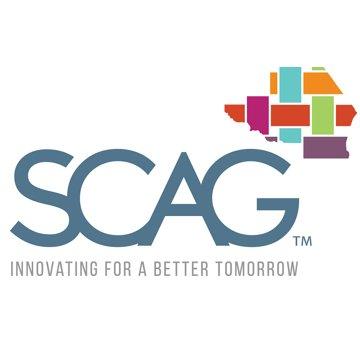
RHNA Appeal
Pursuant to State Law, any local jurisdiction within the SCAG region may file an appeal to modify its allocated share or another jurisdiction’s share of the regional housing need included as part of SCAG’s Draft Regional Housing Needs Assessment (RHNA) Allocation Plan. The period for local jurisdictions to file appeals with SCAG began on September 11, 2020.
The City of Garden Grove officially filed two (2) appeal applications to SCAG.
City of Garden Grove Appeal of the RHNA Allocation of 19,122 Units Letter
Appeal of the City of Santa Ana’s RHNA Allocation of 3,087 Units Letter
Following the end of the appeals filing period, SCAG notified all jurisdictions within the region and HCD of all appeals and made all materials submitted in regards to each appeal available on its website. Local jurisdictions and HCD were permitted to comment on the appeals within the 45 day comment period. Comments related to the appeal filings by the City of Garden Grove are linked below:
Orange County Mayors Comment Letter dated September 18, 2020
HCD Comment Letter Regarding All RHNA Appeals Filed dated December 10, 2020
Public Law Center Comment Letter on the City of Garden Grove’s Appeal dated December 10, 2020
City of Santa Ana Comment Letter In Response to the Appeals of Santa Ana’s RHNA Allocation dated December 10, 2020
For a full list of all RHNA comment letters received and posted by SCAG please visit, SCAG’s RHNA Comment Letters page.
SCAG’s Regional Council delegated the responsibility of considering appeals regarding draft allocations to the RHNA Subcommittee, also referred to as the RHNA Appeals Board. The agenda and hearing materials were posted on the Southern California Association of Governments (SCAG) website. All hearings were held via teleconference in accordance with the RHNA Appeals Procedures.
SCAG posted a RHNA Appeals Hearing Notice and Schedule on its website, which is linked below. The hearings applicable to the (2) appeal filings by the City of Garden Grove were denied.
Additional information may be found on SCAG’s website: www.scag.ca.gov/rhna.
Income Group |
% of Median Household Income |
Income Range (4-person household) |
5th Cycle RHNA Allocation (Housing Units) |
6th Cycle RHNA Allocation (Housing Units) |
|---|---|---|---|---|
Very-Low Income |
<50% of AMI |
$0 - $44,880 |
164 |
4,166 |
Low Income |
50-80% of AMI |
$44,881 - $71,807 |
120 |
2,801 |
Moderate Income |
81-120% of AMI |
$71,808 - $107,711 |
135 |
3,211 |
Above-Moderate Income |
|
$107,712+ |
328 |
8,990 |
Total |
747 |
19,168 |
Recent Housing Legislation
The 2019 California Legislative Session ended with over 30 new bills in response to the state’s worsening housing crisis. Several of these bills are designed to increase housing production by easing development regulations, compelling jurisdictions to make fee and land information readily available to potential developers, and impose new ongoing reporting and inventory requirements for local jurisdictions. The following table displays the bills discussed in the update and includes links to the corresponding bill text:
| Category | Bill Title |
| Bills Removing Barriers to Boost Housing Production | SB 330 – Housing Crisis Act of 2019 and Changes to Permit Streamlining Act & Housing Accountability Act |
| AB 1763 – Density Bonuses for Affordable Housing | |
| AB 1743 – Eligibility of Property Welfare Exemptions | |
| AB 116 – Enhanced Infrastructure Financing Districts | |
| Surplus Land Databases and Reporting Requirements | AB 1486 / SB 6 / AB 1255 – Expansion of Surplus Land Act and Reporting |
| AB 1483 – Housing Data Collection and Reporting | |
| Requirements for Accessory Dwelling Units | AB 68 / AB 881 / SB 13 – Modifications to Increase Accessory Dwelling Unit Development |
| AB 587 – Sale of Accessory Dwelling Units | |
| AB 670 – Construction of Accessory Dwelling Units in Common Interest Developments | |
| AB 671 – Affordable Accessory Dwelling Unit Program Creation | |
| Established "Uses by Right" | AB 101 – Housing and Homelessness Budget and Regulations |
| SB 234 – Keeping Kids Closer to Home Act | |
| Related Housing Element Laws from 2017 Housing Package | SB 166 – "No Net Loss" Law |

Visit HCD Website
Additional resources can be found on the California Department of Housing and Community Development website.
- Why update the housing element?
- What is included in a Housing Element?
- What is RHNA?
- Does RHNA require us to build housing?
- What is the relationship to other Elements of the General Plan?
California State law requires that the City of Garden Grove update the Housing Element every eight years. These frequent updates are required because housing is critical to ensure economic prosperity and quality of life in our region. The revised Housing Element must be adopted by the Garden Grove City Council, or the City of Garden Grove could lose eligibility for significant sources of funding currently provided by the State.
The components of the Housing Element are largely dictated by the State. The following chapters must be included:
- A detailed analysis of the City’s demographic, economic and housing characteristics.
- A comprehensive analysis of constraints to producing and preserving housing.
- A review of the City’s progress in implementing current housing policies and programs.
- An identification of goals, objectives, and policies, in addition to a full list of programs that will implement the vision of the plan.
- A list of sites that could accommodate new housing, demonstrating the City’s ability to meet our Regional Housing Needs Assessment (RHNA).
Because the Housing Element is updated frequently, the previous element provides a foundation for this update. This update gives us the opportunity to evaluate the previous element and determine which parts have been effective and which should be improved.
RHNA stands for “Regional Housing Needs Assessment.” Every eight years, the State of California provides the number of housing units that should be accommodated in the Southern California region. The Southern California Regional Association of Governments (SCAG) takes that larger number and devises a methodology to allocate the units among the SCAG region. As a part of the Housing Element, Garden Grove must demonstrate to the State that there is available capacity for the units allocated to the City. This year, the regional allocation, and therefore our Garden Grove City allocation, was significantly larger than it has been in past years. This large allocation was a result of the State responding to the housing crisis by considering both “projected need” (i.e., units we need to accommodate new residents) and “existing need” (i.e., units we need to alleviate challenges like overcrowding and homelessness). The allocation also takes affordability into account by identifying the percentage of units that are needed at each income level (very low, low, moderate, and above moderate).
The final RHNA allocation as released by SCAG is 19,168 units. Of this total allocation, approximately 36% should be available to very-low and low income units, 17% to moderate income, and 47% to market rate.
Visit the SCAG website for more information on RHNA and the RHNA allocation process.
Through the RHNA process, we must show that the City has the regulatory and land use policies to accommodate housing needs, but the actual development of housing is largely conducted by the private market. The Housing Element is required to demonstrate potential sites where housing can be accommodated. Identification of a site’s capacity does not guarantee that construction will occur on that site. If there are insufficient sites and capacity to meet the RHNA allocation, then the Housing Element is required to identify a rezoning program to create the required capacity. It is important to note that if we fall significantly behind on our RHNA targets, the City of Garden Grove could be deemed out of compliance and risk losing important sources of funding currently provided by the State.
The Housing Element must remain consistent with the other elements of the General Plan. The City of Garden Grove has created an Environmental Justice Element, as well as updated it’s Safety Element and Land Use Element (including adoption of necessary amendments to the Zoning Map/Code).
Email List - Stay Connected
The best way to stay connected and to receive updates on the Housing Element is to join the email list.
Presented on Wednesday, July 14, 2021
Presented on Wednesday, April 21, 2021
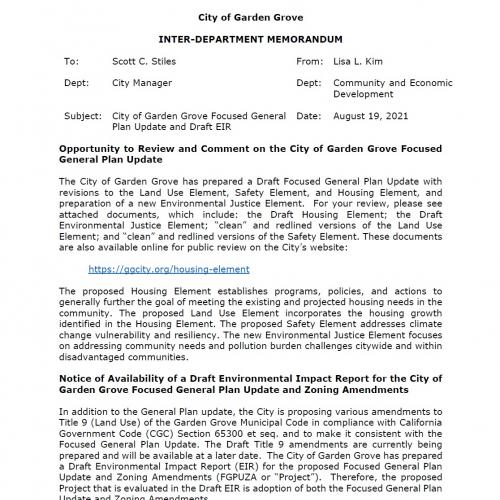
A notification of availability to the City Council and community stakeholders of the Draft Focused General Plan Update (available on the City’s website) with revisions to the Land Use Element, Safety Element, and Housing Element, and preparation of a new Environmental Justice Element. Also a notice of availability of the Draft EIR for the Focused General Plan Update and Zoning Amendments (FGPUZA).
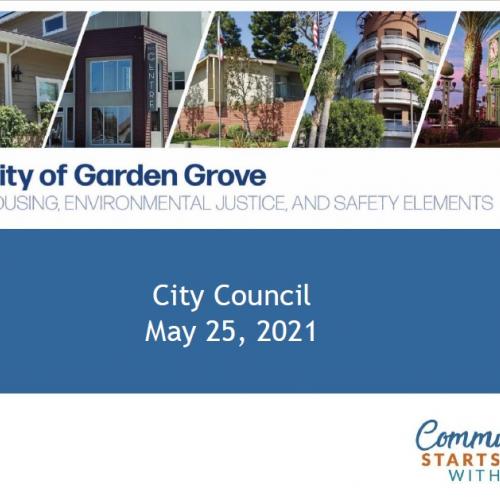
Study session to present the goals, polices, and programs for the Housing Element Update. Presented goals and policies that address: housing maintenance and preservation; affordable housing; adequate housing sites; removal of constraints to housing production; equal access to housing; and community engagement.
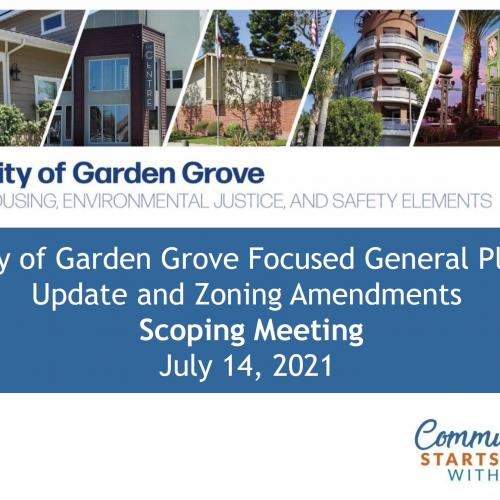

Study session to present the goals, polices, and programs for the Housing Element Update. Presented goals and policies that address: housing maintenance and preservation; affordable housing; adequate housing sites; removal of constraints to housing production; equal access to housing; and community engagement.


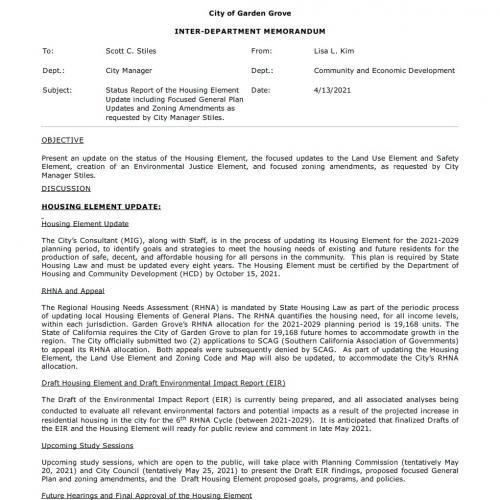
An update on the status of the Housing Element, the focused updates to the Land Use Element and Safety Element, preparation of the Environmental Justice Element, and focused zoning amendments. An update on the City’s RHNA (2) appeal applications, which were denied by SCGA. An update on the City’s recent public outreach efforts, and next steps in the process. Also, notification of an upcoming virtual community forum, open to the public, to present information and receive community input on environmental justice issues in Garden Grove.

A summary of the responses and comments received via the online mapping survey, which focused on Housing and Environmental Justice. An overview of RHNA and the proposed land use alternatives which identify housing density strategies to achieve a plan to meet the State’s required RHNA allocation of 19,168 housing units.

Presented an overview of the public engagement efforts conducted thus far, along with comments received from stakeholders and the public. Presented summary of community survey responses and online mapping survey results received thus far. Presented summary of comments received from prior Virtual Community Meeting and Planning Commission Study Session. A presentation on RHNA, the City’s preliminary plan and potential land use alternatives to meet the State required RHNA objective. Also, a presentation and exercise on residential density and potential housing opportunity sites for residential development. Future public engagement, project timeline, upcoming online mapping survey, and next steps presented. Also, an update to the City’s RHNA appeal efforts.
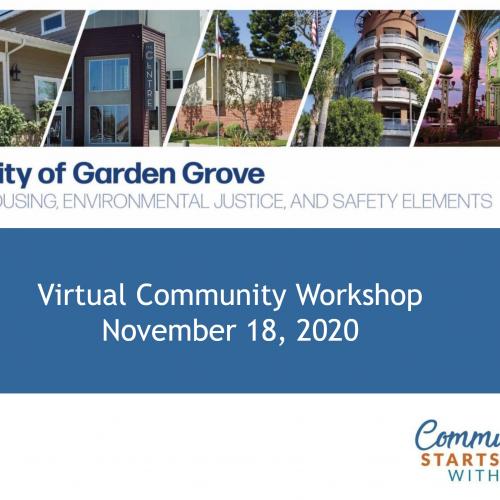
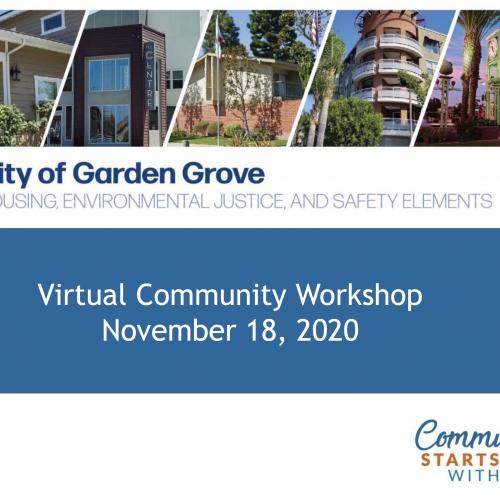
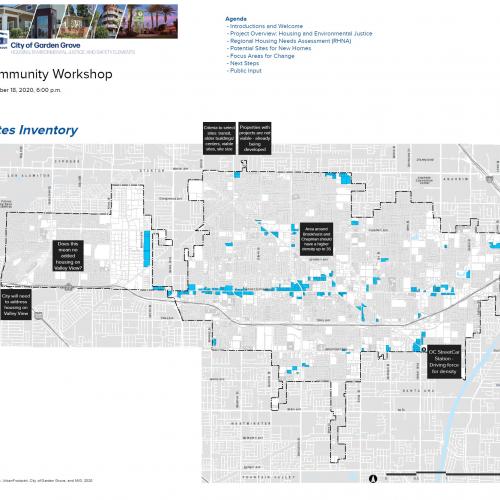
Virtual Community Meeting
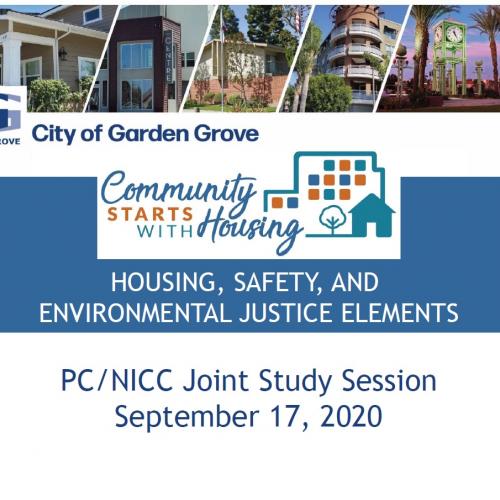
Presentation Video (YouTube)
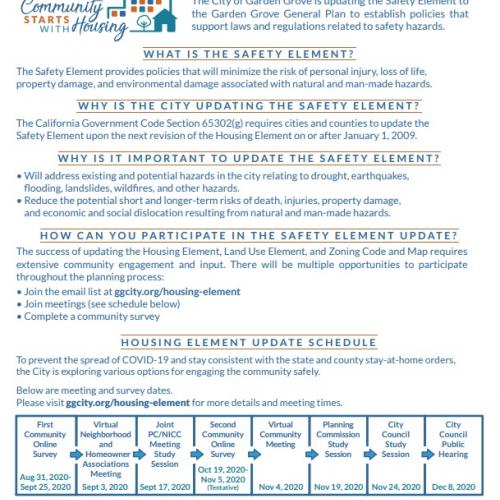

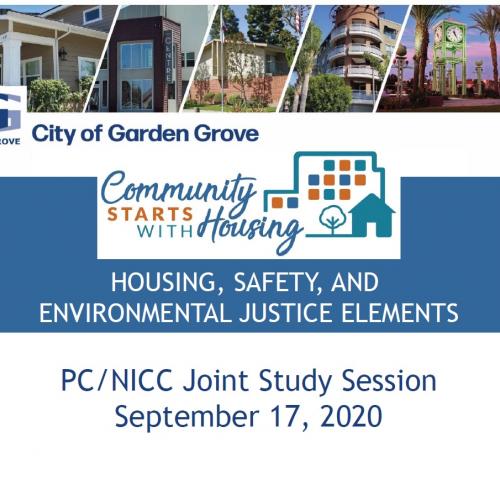
PowerPoint Presentation
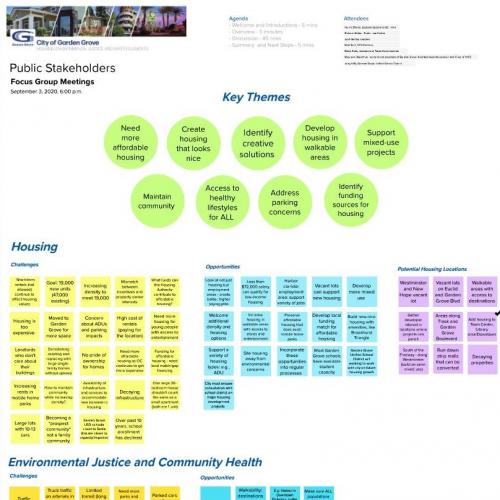
Virtual Neighborhood and Homeowner Associations Meeting
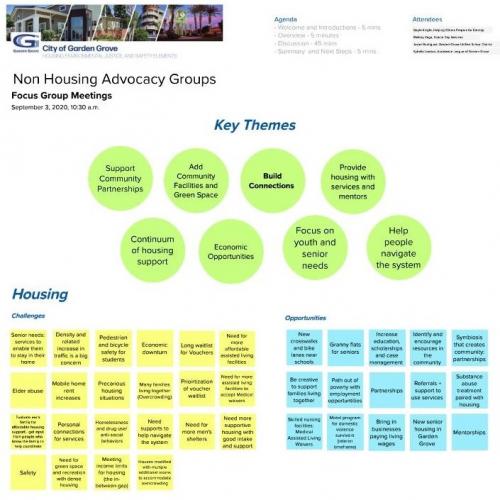
Non-Housing Advocacy Groups
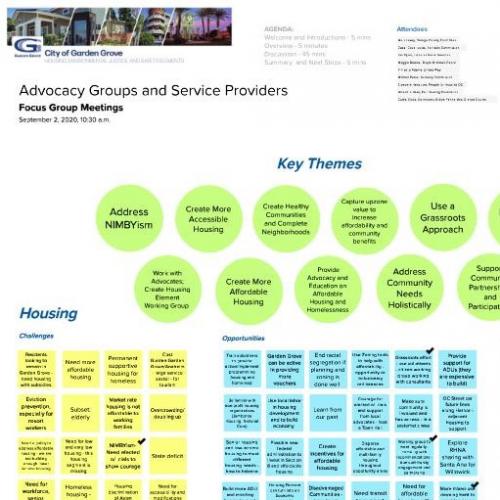
Service Providers and Advocacy Groups

Housing and Affordable Housing Developers



